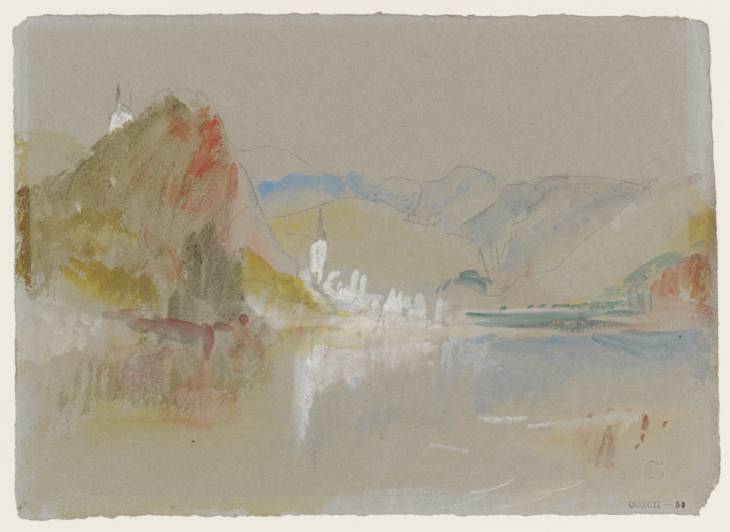Joseph Mallord William Turner Treis on the River Mosel, from the North 1840
Joseph Mallord William Turner,
Treis on the River Mosel, from the North
1840
Joseph Mallord William Turner 1775–1851
Treis on the River Mosel, from the North 1840
D28998
Turner Bequest CCXCII 50
Turner Bequest CCXCII 50
Pencil, watercolour and gouache on grey wove paper, 140 x 195 mm
Blind-stamped with Turner Bequest monogram towards bottom right
Stamped in black ‘CCXCII – 50’ bottom right
Blind-stamped with Turner Bequest monogram towards bottom right
Stamped in black ‘CCXCII – 50’ bottom right
Accepted by the nation as part of the Turner Bequest 1856
Exhibition history
1896
Sixth Loan Collection, National Gallery, London 1896, Bradford Art Gallery 1897–1904, Hanley Museum 1905–6, National Gallery, London 1907, Wolverhampton Art Gallery 1908, National Gallery, London 1908, Manchester Municipal Art Gallery 1909–10, Leeds City Art Gallery 1911–12, Blackburn Art Gallery 1913, Central Public Library and Museum, Bootle, July 1914, Bradford Art Gallery 1915–18, Blackburn Art Gallery 1919–22, Wolverhampton 1923, Tate Gallery, London 1924–6, Swansea 1927–9, Hastings 1930, transferred to the British Museum, London 1931 (no catalogue, but numbered 45).
1995
Turner in Germany, Tate Gallery, London, May–September 1995, Städtische Kunsthalle Mannheim, September 1995–January 1996, Hamburger Kunsthalle, Hamburg, January–March 1996 (75, as ‘Treis from the North’, 1840, reproduced).
References
1834
A.J. Finberg, A Complete Inventory of the Drawings of the Turner Bequest, London 1909, vol.II, p.941, CCXCII 50, as ‘River scene, with town and mountains. 6th Loan Collection, No.45’, c.1834.
1995
Cecilia Powell, Turner in Germany, exhibition catalogue, Tate Gallery, London 1995, pp.145 under no.67, 150–1 no.75, as ‘Treis from the North’, 1840, reproduced.
This River Mosel subject was first identified by Cecilia Powell: ‘Turner’s viewpoint is looking upstream from Karden and includes the little white Zilleskapelle on its cliff with the town of Treis beyond.’1 The two settlements, set diagonally on the opposite banks, now form the municipality of Treis-Karden and are linked by a bridge from the south end of Karden to the north end of Treis, across the reach encompassed by Turner’s view.
See also the 1824 Rivers Meuse and Moselle sketchbook (Tate D19799–D19801; Turner Bequest CCXVI 124a–125v), the 1839 First Mossel and Oxford book (D28315; CCLXXXIX 13) and the Cochem to Coblenz – Home book of the same year (D28554–D28555, D28557; CCXCI 9a, 10, 11). There are gouache studies on blue paper associated with the 1839 tour (Tate D20233, D24735; Turner Bequest CCXX Z, CCLIX 170). Powell has noted: ‘In both composition and colouring the scene is very like that of the previous year [D20233], but Turner’s handling is far more sketchy, the patches of colour left as abstract shapes rather than being tidied up to represent particular features of the landscape.’2
For the full range of Mosel subjects associated with the present tour, see the Introduction to this subsection.
The verso is D28999 (Turner Bequest CCXCII 50v), with an unrelated pencil drawing of the Leyen Burg (Schloss von der Leyen) at Gondorf, roughly ten miles down the river.
Technical notes:
The sheet is noticeably browned, and the yellows and browns of the landscape are quite faded except at the strips around the edges, formerly protected by a mount during prolonged display as part of the Sixth Loan Collection.
Cecilia Powell has noted this as one of the many sheets of grey 1829 Bally, Ellen and Steart paper used on Turner’s 1840 tour, neatly torn as eighths or sixteenths of the overall sheet, with dimensions of around 190 x 280 or 140 x 190 mm, and variously worked with pencil, watercolour and gouache; see the technical notes in the overall Introduction for others.1
More specifically, the present section ‘originally formed part of the same sheet as eight others of the same size which bear pencil drawings of the Rhine on both recto and verso. These include views of Bonn, the Godesburg, Rolandseck, the Drachenfels, Hammerstein and Burg Rheineck (TB CCCXLI 194–209 [Tate D33899–D33914, of which D33903, D33904 and D33906 are blank]). The sheet is watermarked BE&S / 1829.’2 These subjects are also catalogued in this subsection.
Matthew Imms
September 2018
How to cite
Matthew Imms, ‘Treis on the River Mosel, from the North 1840 by Joseph Mallord William Turner’, catalogue entry, September 2018, in David Blayney Brown (ed.), J.M.W. Turner: Sketchbooks, Drawings and Watercolours, Tate Research Publication, December 2019, https://www

